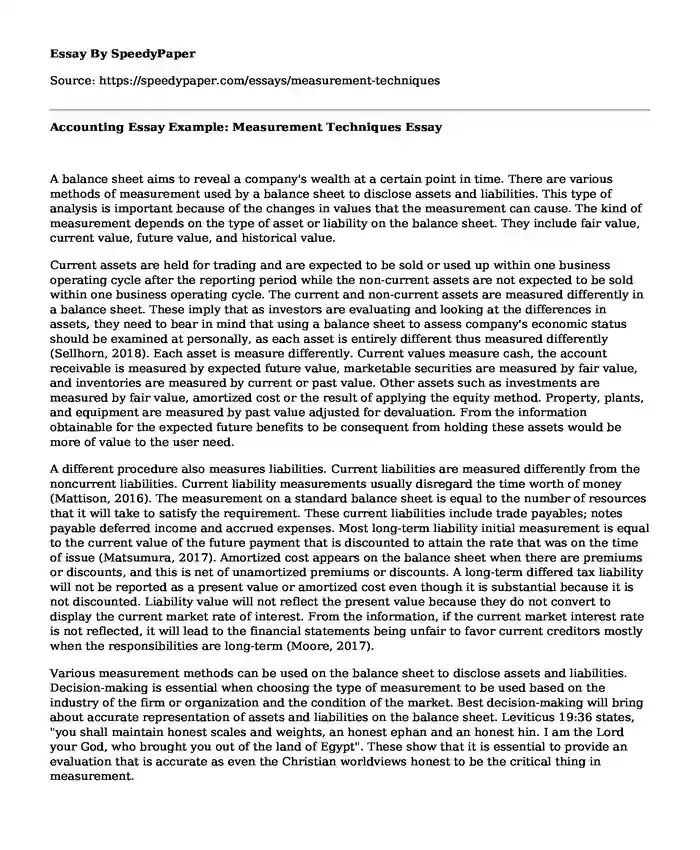
| Type of paper: | Case study |
| Categories: | Accounting Financial management |
| Pages: | 3 |
| Wordcount: | 642 words |
A balance sheet aims to reveal a company's wealth at a certain point in time. There are various methods of measurement used by a balance sheet to disclose assets and liabilities. This type of analysis is important because of the changes in values that the measurement can cause. The kind of measurement depends on the type of asset or liability on the balance sheet. They include fair value, current value, future value, and historical value.
Current assets are held for trading and are expected to be sold or used up within one business operating cycle after the reporting period while the non-current assets are not expected to be sold within one business operating cycle. The current and non-current assets are measured differently in a balance sheet. These imply that as investors are evaluating and looking at the differences in assets, they need to bear in mind that using a balance sheet to assess company's economic status should be examined at personally, as each asset is entirely different thus measured differently (Sellhorn, 2018). Each asset is measure differently. Current values measure cash, the account receivable is measured by expected future value, marketable securities are measured by fair value, and inventories are measured by current or past value. Other assets such as investments are measured by fair value, amortized cost or the result of applying the equity method. Property, plants, and equipment are measured by past value adjusted for devaluation. From the information obtainable for the expected future benefits to be consequent from holding these assets would be more of value to the user need.
A different procedure also measures liabilities. Current liabilities are measured differently from the noncurrent liabilities. Current liability measurements usually disregard the time worth of money (Mattison, 2016). The measurement on a standard balance sheet is equal to the number of resources that it will take to satisfy the requirement. These current liabilities include trade payables; notes payable deferred income and accrued expenses. Most long-term liability initial measurement is equal to the current value of the future payment that is discounted to attain the rate that was on the time of issue (Matsumura, 2017). Amortized cost appears on the balance sheet when there are premiums or discounts, and this is net of unamortized premiums or discounts. A long-term differed tax liability will not be reported as a present value or amortized cost even though it is substantial because it is not discounted. Liability value will not reflect the present value because they do not convert to display the current market rate of interest. From the information, if the current market interest rate is not reflected, it will lead to the financial statements being unfair to favor current creditors mostly when the responsibilities are long-term (Moore, 2017).
Various measurement methods can be used on the balance sheet to disclose assets and liabilities. Decision-making is essential when choosing the type of measurement to be used based on the industry of the firm or organization and the condition of the market. Best decision-making will bring about accurate representation of assets and liabilities on the balance sheet. Leviticus 19:36 states, "you shall maintain honest scales and weights, an honest ephan and an honest hin. I am the Lord your God, who brought you out of the land of Egypt". These show that it is essential to provide an evaluation that is accurate as even the Christian worldviews honest to be the critical thing in measurement.
References
Sellhorn, T., & Stier, C. (2018). Fair value measurement for long-lived operating assets: Research evidence. European Accounting Review, 1-31.
Miller-Nobles, T. L., Mattison, B., & Matsumura, E. M. (2016). Horngren's Financial & Managerial Accounting: The Managerial Chapters. Pearson.
Bricker, J., L. J., Henriques, A., Hsu, J. W., Jacobs, L., Moore, K. B., ... & Windle, R. A. (2017). Changes in US family finances from 2013 to 2016: evidence from the survey of consumer finances. Fed. Res. Bull., 103, 1.
Cite this page
Accounting Essay Example: Measurement Techniques. (2022, Jul 25). Retrieved from https://speedypaper.com/essays/measurement-techniques
Request Removal
If you are the original author of this essay and no longer wish to have it published on the SpeedyPaper website, please click below to request its removal:
- Introduction to Philosophy, Essay Example
- Causes and Social Effects of Dementia - Free Essay
- Free Essay: 2016 Olympic Games Analysis Related to Other Olympic Games and Marketing
- Essay Sample that Comprises Electronic Health Records System Presentation
- Essay Example on Braaksma's Lessons Learned From the Assembly Line
- Essay Example: Physiology for Psychologists
- Essay Sample on Sports Event Project Plan Report
Popular categories




